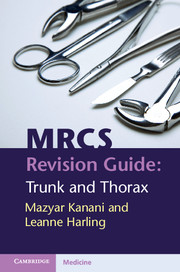Book contents
- Frontmatter
- Contents
- Preface
- Section 1 Clinical surgery in general
- Section 2 Thorax
- Chapter 2 Applied surgical anatomy
- Chapter 3 Applied surgical physiology: cardiovascular
- Chapter 4 Surgical approaches to the chest
- Chapter 5 The mediastinum and diaphragm
- Chapter 6 The breast: benign and malignant disease
- Section 3 Trunk
- Bibliography
- Index
Chapter 4 - Surgical approaches to the chest
Published online by Cambridge University Press: 05 February 2012
- Frontmatter
- Contents
- Preface
- Section 1 Clinical surgery in general
- Section 2 Thorax
- Chapter 2 Applied surgical anatomy
- Chapter 3 Applied surgical physiology: cardiovascular
- Chapter 4 Surgical approaches to the chest
- Chapter 5 The mediastinum and diaphragm
- Chapter 6 The breast: benign and malignant disease
- Section 3 Trunk
- Bibliography
- Index
Summary
What are the common approaches to the thoracic cavity?
Median sternotomy
The patient is positioned supine on the operating table. A midline skin incision is made from the jugular notch to the xiphisternum. Using monopolar diathermy this is then extended through the subcutaneous fat, being careful to remain in the midline until the sternum is reached. Blunt dissection with a finger is then used to clear tissues below the xiphisternum and around the top of the manubrium. The interclavicular ligament is divided with diathermy and the xiphisternum is cut with McIndoes scissors. The sternal saw is then used to divide the bone and a retractor is placed to expose the anterior mediastinum.
Posterolateral thoracotomy
The patient is positioned prone or in a lateral position dependent on the structures to be accessed. A long parascapular incision is made, running from a point midway between the medial scapular edge and the thoracic spine and following a curve that runs 2 cm below the inferior scapular angle, to the midpoint of the axilla.
- Type
- Chapter
- Information
- MRCS Revision Guide: Trunk and Thorax , pp. 28 - 29Publisher: Cambridge University PressPrint publication year: 2012



